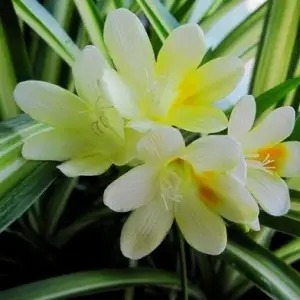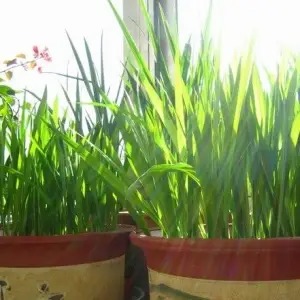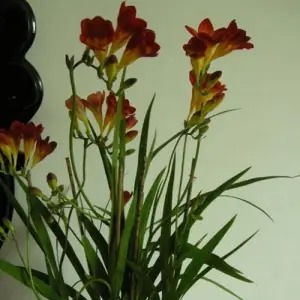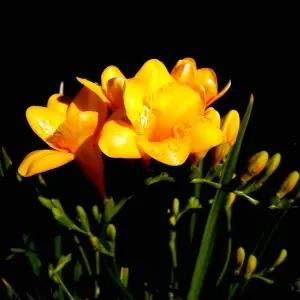Freesia cultivation methods and precautions

Freesia (Fressia hybrida Klatt.), also known as freesia , small iris , scissors orchid, plain fragrant orchid , fragrant iris , and foreign tuberose , is a perennial bulbous herbaceous flower belonging to the genus Freesia of the family Iridaceae . Freesia flowers are pure white like snow and have a delicate orchid-like fragrance , hence the name Freesia .
It is native to the Cape of Good Hope in southern Africa . There are about 20 species, which are often divided into red, yellow, white, blue and other cultivated varieties according to flower color . Because of its early flowering period, bright color, fragrant flowers and long flower arrangement period, it can be supplied to the market in early spring and Spring Festival . It can be cultivated as cut flowers or greenhouse potted plants , and is deeply favored by flower lovers.
Perennial herb. Conical bulb. Linear leaves, alternate in two rows, inclined spiral shell inflorescence, narrow funnel-shaped flowers. Main varieties include lavender "Blue Sister", bright yellow "Cream Cup", red "Quick Red", white "Meiyou" and orange "Spring Day".
There are about 20 species of freesia in the world, mainly distributed in southern Africa. Common freesia has long been widely cultivated in various places. However, its flowers are small, the flower stems are short, the flower color is green-yellow to bright yellow, and the variety is monotonous. Most of the cultivated freesias are artificially improved. Their flowers are larger than before, the color is richer, the number of flowers on the flower stem has also increased, and the petals are thicker and the fragrance is strong.
It is mostly cultivated outdoors in the south and potted in the north. It is for viewing and its flowers can be used to extract essence.
1. Morphological characteristics
Perennial bulbous herbaceous flower. The bulb is narrowly ovate or oval, covered with a thin membrane with reticular patterns and dark red spots. The leaves are sword-shaped or strip-shaped, slightly curved , 15 to 40 cm long, 0.5 to 1.4 cm wide, yellow- green , with a distinct midrib. The flower stem is erect, with 2-3 curved branches at the top and several leaves at the bottom; the flowers are sessile; each flower has 2 membranous bracts at the base, which are broadly ovate or ovate, slightly concave or 2-pointed at the top, 0.6-1 cm long and about 8 mm wide; the flowers are erect, light yellow or yellow-green, fragrant, and 2-3 cm in diameter; the perianth tube is trumpet-shaped, about 4 cm long and about 1 cm in diameter, tapering at the base, with 6 perianth lobes arranged in 2 whorls, the outer perianth lobes are ovate or elliptical, 1.8-2 cm long and about 6 mm wide, and the inner whorls are slightly shorter and narrower than the outer perianth lobes; there are 3 stamens, attached to the perianth tube, 2-2.5 cm long; there is 1 style, with 6-lobed stigma, and the ovary is green, nearly spherical, and about 3 mm in diameter . The capsule is nearly ovate and dehisces on the back of the chamber. The flowering period is April to May, and the fruiting period is June to September .
2. Growth habits

Freesia prefers a cool, humid and well-lit environment . It has poor cold resistance. The suitable temperature for growth is 15-20℃, and the minimum temperature for wintering is 3-5℃.
3. Geographical Distribution
It is native to the Cape of Good Hope in southern Africa . It is mostly cultivated outdoors in the south and potted in the north.
4. Cultivation Technology

Seed selection
The bulbs for cultivation should be large bulbs with a diameter of more than 1 cm. In order to reduce virus infection, virus-free tissue culture bulbs or new bulbs cultivated from seeds and daughter bulbs must be selected. Generally, tissue culture seedlings or seeds are used for sowing. After 1 to 2 years of cultivation, small bulbs can be cultivated into high-quality bulbs.
1. Bulb pretreatment
Before planting, the bulbs need to be disinfected , dormancy broken, rooting promoted, and other pretreatments. To disinfect the bulbs, soak the bulbs with 500-800 times diluted carbendazim or methyl thiophanate fungicides for 1-2 hours, pick them up and dry them in the shade. Root-promoting treatment should be done after roots grow out , and rooting should not be too long, otherwise the root system will be easily damaged during planting .
2. Planting
The general cultivation and planting period is from September to October. Through the protection facilities to overwinter , the main flowering period is from March to April. When planting, if the sowing is arranged appropriately, and then the forcing cultivation and delayed cultivation are adopted, the freesia can provide flowers all year round. The cultivation distance varies according to the variety, bulb size, and cultivation season. The general planting row spacing is 8cm×(10-14)cm, and the planting density is 80-110 plants per square meter. Narrow-leaf varieties are planted denser than wide-leaf varieties, winter cultivation is denser than summer planting, and small bulbs are denser than large bulbs. When planting, the soil is usually covered with 2-3cm, and it should not be too thick. After planting, the soil surface is often covered with a thin layer of peat soil or pine needles, straw , sawdust, etc. to keep the soil moist.
Soil conditions
Freesia prefers sandy loam with rich organic matter , strong water retention and good drainage , pH 6-7.2. Before planting, the soil can be disinfected with 6-10g of pentachloronitrobenzene, 50-70g of methyl bromide , and 8-12g of cyanamide per square meter. After applying the pesticide, turn the rake and level it, and sow it every 5-7 days. The height of the planting bed is about 5cm in arid areas; the bed surface is 20-25cm for beds with high soil humidity and poor drainage. Acidic soil is more suitable for planting.
Cultivation management

Closely coordinate the time of bulb purchase with the time of cut flower marketing. Freesia flowering bulbs are usually supplied by specialized growers, with a circumference of 5 to 7.5 cm. Ordering bulbs should be made at least 4 months in advance, and the bulbs should be stored at 30°C for at least 3 months before being shipped to cut flower producers. After the bulbs arrive, if they cannot be planted for a while, they must not be stored at 30°C, but refrigerated at 13°C, and the refrigeration time should not exceed 3 weeks. The growth and development of freesia is regulated by temperature and light. In order to accurately control the growth and development of bulbs and plants, cut flower producers must coordinate with bulb suppliers on pre-cooling treatment and planting time. In North America, the planting time of freesia lasts from September in the north to November in the south. When there are soil cooling facilities, freesia can be planted all year round. The time from planting to flowering of freesia varies depending on the variety and greenhouse temperature. Generally, it will bloom 110 to 120 days after planting. The flowers will continue to be produced for 4 weeks. To form a production pattern that continues to produce flowers for several months, the planting times must be staggered.
Use a well-drained, chloride-free and pathogen-free culture medium with a pH between 5.8 and 7.2. The culture medium should be at least 25 cm thick. Freesia is very sensitive to chlorine, which can cause burns on its leaves[4]. Therefore, do not use superphosphate or other chlorine-containing fertilizers. Also avoid using chlorinated irrigation water.
Use high light intensity and low forcing cultivation temperature during cultivation. Freesia requires moderate to high light intensity (2500-5000f.c.), and night temperature is maintained between 10-13℃. Daytime temperature should not exceed 17℃, especially in the short-day period in winter. In summer, measures should be taken to reduce soil temperature to prevent soil temperature from rising above 17℃. Note that during the period of rapid development of freesia buds, low light intensity or high temperature often causes flower bud abortion.
Sell cut flowers at the right time, and use equipment to lower soil temperature to achieve year-round flower supply. When the first flower at the lowest position of the freesia blooms, the cut flowers can be harvested. The blooming flowers of the freesia are not sensitive to ethylene, but the buds are very sensitive. They can be pre-treated with 1-MCP to prevent bud loss. For short-term storage of freesia, dry storage without immersion in water is adopted, and the temperature is maintained at 0-2°C and the relative humidity is 95%. For long-term storage, immerse the flowers in water and maintain the temperature at 0.5-2°C.
Freesia is prone to mosaic disease , bulb rot, etc. Prevention and control methods: Thoroughly disinfect the soil and bulbs when planting , and completely replace the potting soil every year. At the same time, pay attention to the prevention and control of aphids . In the early stage of aphids, spray 40% omethoate 1500 times liquid or 90% trichlorfon liquid for prevention and control.
After the seedlings are treated with temperature changes, they can bloom in the same year.
Fertilizer and water management
The soil must be kept moist from planting to budding . After budding, watering should be gradually reduced to keep the soil surface dry as much as possible to reduce air humidity and prevent diseases. The time from planting to flowering is short, and the organic fertilizer and compound fertilizer applied before planting can basically meet the growth needs. However, if the plant grows weakly, apply ammonium nitrate , urea and potassium sulfate once more when it has 2 to 4 leaves . Use 0.2% potassium dihydrogen phosphate as foliar fertilizer when it first blooms , but it is best to avoid topdressing before and after budding.
Temperature Management
Temperature management is very important for the production of freesia cut flowers. Generally, the inflorescence is fully differentiated about 6 weeks after planting, and smaller bulbs will be delayed by 2 to 3 weeks. During the flower bud differentiation period, high temperatures above 25°C and low temperatures below 10°C should be avoided. From the 4- leaf stage , the temperature must be maintained at 13 to 14°C for more than 4 weeks to smoothly induce the differentiation of flower primordia during the 4-6 leaf period, which is beneficial to the improvement of cut flower yield and quality. After the flower buds appear , the ambient temperature should be appropriately increased to promote flowering; but in order to prolong the flowering period, when the first flower blooms, the temperature can be lowered to about 15°C to extend the cut flower harvest period. In greenhouse and hothouse management, attention should be paid to ventilation when the room temperature is above 25°C, and covering or heating should be added when the room temperature is below 10°C.
Lighting Management
During the cultivation process, appropriate shading is recommended during the seedling and flowering stages. During the first leaf growth period, appropriate shading can reduce ground temperature and promote root development. Short-day treatment of about 10 hours before flower bud differentiation is beneficial to promote flower bud differentiation, increase flower stem length and the number of flowers and side spikes on the inflorescence . After the flower bud differentiation is completed, appropriately extending the daylight is beneficial to promote the good development of the inflorescence and early flowering. Although freesia likes light, it should also avoid strong light exposure. When the light is too strong and the temperature is high, a shade net with a light transmittance of 70% can be used for shade.
Pull Net
Freesia branches are relatively soft, and the inflorescence grows in a zigzag pattern. When there are many flowers, the branches tend to droop and fall over. When the plant has 3 to 4 leaves, you can start setting up a support net. Set the first layer of net about 25 cm from the ground, and set up 2 to 3 layers of net as the plant grows. Generally, the grid of the net is 10 cm × 10 cm or 10 cm × 15 cm square.
Cut flower harvesting
When the first floret on the main branch of Freesia opens, it is the right time to harvest. If long-distance transportation or storage is required, it should be cut when the first floret is exposed or half-opened. The cutting tool should be disinfected with alcohol to prevent infectious diseases. The cutting position is generally at the base of the main branch of the plant , so that the side flowers below the main branch can continue to be harvested for the second or third time. The length of the commercial cut flower branch is required to be more than 55cm. If the cut flower inflorescence is small and the flower stem is too short to affect the product quality, the main branch can be cut together with the side branches and then the side branches can be cut off. After cutting , the cut flowers are graded and bundled according to the quality of the branches , with 10 or 20 branches in a bundle . The flower part is wrapped with paper and placed in fresh-keeping liquid or clean water to absorb water. Dry storage or wet storage at a temperature of 1-2°C and a relative humidity of 90% can keep fresh for 7 days; it is packed in cartons for external use. 300-500 branches per box. When cutting the flowers for the last time , at least 2 leaves should be retained to facilitate the development of the underground bulbs . The bulbs are usually collected after the leaves turn yellow.
Variety classification
Freesia (Flora of Guangzhou), Acorus calamus (name of the Lahan seed plant), Acorus calamus (Wuhan) are native to southern Africa.
Main value: ornamental value
For viewing, the flowers can be used to extract essential oils.
Yellow freesia and red lily as the main flowers, with strelitzia, tricolor cordyline leaves, and brown bamboo leaves, represent yearning for brightness and the future. If freesia and red phalaenopsis are used as the theme flowers, with magnolia, asparagus fern, silk lily, and dragon willow branches, the room will be elegant and dignified.
Freesias are like lilies, with leaves like orchids, simple and elegant flowers, delicate and beautiful, rich fragrance, and long flowering period. They are popular indoor ornamental flowers in winter and spring. There are many gardening varieties. They are often potted or cut branches and put into vases to decorate the interior. They are ideal potted flowers for embellishing living rooms and study rooms .
Medicinal value
Freesia is commonly known as " ginger flower ". Its fragrance has the effect of calming nerves , eliminating fatigue and promoting sleep.
Other plant cultural names
According to legend, in the early 18th century, this flower was still in the wild. One day, a Dutch noble lady went hunting with her lover in South Africa and saw this exotic flower for the first time. She loved it very much and later picked it herself and brought it back to Europe. The fragrant flower was blown to the snow along the way by the wind, and even the ice and snow were stained with rich fragrance. People gave it a beautiful name: "freesia".
Fresh-keeping storage
Developmental stage for cutting: Cut when the first flower on the inflorescence is colored and opening, and before the second flower begins to open.
Vase life: If handled properly, the vase life of Fragrant Snow Flower can reach 7 to 14 days.
Preservative treatment method
Hydration treatment liquid: Adjust the pH of deionized water or good quality tap water to pH 3.5 with citric acid. Do not add fluoride to the water.
1-Methylcyclopropene (1-MCP) treatment.
Vase preservation solution: 4% sucrose + 0.015% aluminum sulfate + 0.2% magnesium sulfate + 0.1% potassium sulfate; or add 250 mg of 8-hydroxyquinoline citrate + 70 mg of chlormequat (CCC) + 50 mg of silver nitrate + 60 mg of sucrose per liter of water.
Storage and transport technology
Freesia can be stored at 2°C and 90% relative humidity for about 1 week.
Flowers are easily bruised, so be careful when handling.
Use storage and transportation gel.



